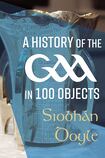
This is one of those books that you start reading and you wonder how in the name of Michael Cusack we managed to get this far without somebody else doing it first. It feels like such an obvious idea – take the nation’s dominant cultural force and humanise it by telling the small stories that have made it what it is.
Siobhán Doyle is a cultural historian, a National Museum employee and a Wexford GAA woman. Given her own constituent parts, therefore, it’s probably just as well nobody tried to do this idea before. The books on sports history that don’t work are either written by historians who can’t help being long-winded or sportswriters who favour craft over deep research. This book hits the sweet spot between the two worlds.
The chapters are short, never more than a few hundred words. The writing is crisp, precise and shorn of fripperies. Some of the objects are genuine national artefacts, like Cusack’s letter to Michael Davin in advance of the 1884 meeting in Thurles at which the GAA was founded. Others are perfectly ordinary, like a hurley-maker’s spokeshave from the 1930s. Other are wry and knowing, like Brian Cody’s cap.
Each of them is used to tell a wider story. The gold key from the opening of Casement Park in 1953. A wooden hurling trophy made by an IRA prisoner in Long Kesh in the early 1980s. A framed hole in the ceiling of a Galway pub, caused by a barman celebrating Pádraic Joyce’s goal in the 1998 All-Ireland final. A manhole cover in Grand Canal Dock painted with the Dublin crest to mark the five-in-a-row in 2019.
Sally Rooney: ‘I enjoy writing about men ... the dangerous charisma of the oppressor class’
Alzheimer’s: ‘I’ve lost my friend and my companion,’ says Úna Crawford O’Brien of fellow Fair City actor Bryan Murray
Ryan Adams at Vicar Street: A gig that nobody will forget anytime soon, but perhaps not for all the right reasons
Meghan Markle’s new podcast: An ego-fluffing conversation underlining the culture gap between Ireland and the US
A hundred chapters, each of them a magic door to a wider world. Triumph, disaster, tragedy, celebration, all accounted for. But the mundane, everyday life of the GAA is here too. A Cúl Camps backpack. A 1930s cigarette card. A 1950s camogie dress. The first GAA PlayStation game. All packaged in a gorgeous, eminently flick-through-able format.
A book for any livingroom, bathroom or bedside locker in the land.
















